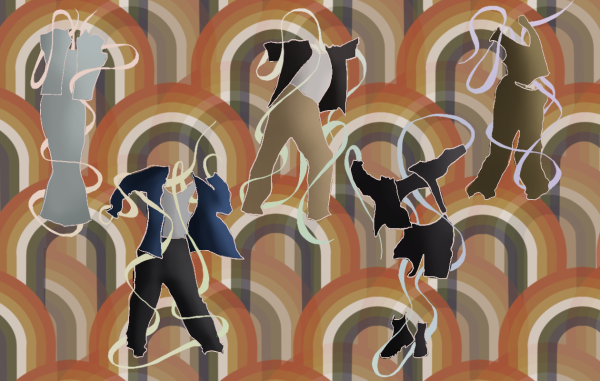is skinny culture coming back?
The 2014 Tumblr Girl seems to be making a comeback. While many millennials who were the main participants of this trend look back and cringe, Gen Z has adopted the style as well as other 2010s aesthetics on TikTok.
Who is the 2014 Tumblr Girl? She’s cool, she’s a loner. She’s grunge, styled after icons such as Effy Stonem from “Skins.” All of her clothes seem ripped. She’s disheveled, but it’s sexy. There’s a lot of eyeliner, and it’s smudged because she just doesn’t care. She’s smoking a cigarette in the corner and very thin. How else would skinny jeans look that good?
Though skinny jeans are far from coming back into style, there is a growing trend toward skinny culture. Whether skinny culture is fueled by the return of these 2010s aesthetics or vice versa, it does not dull the harm this perpetuates on yet another generation. Like many other internet aesthetics, it isn’t confined to a style, but a lifestyle. The trend created an aesthetic around themes of drug use, abuse and self-harm. What seems to go hand in hand with these themes are images of waif-like girls: pale, thin and nearly sickly. Due to the romanticization of the 2014 Tumblr Girl, teens following the trend are returning to the skinny era, this time on TikTok instead of Tumblr.
However, because Tumblr is so integral to the aesthetic, will the site make a resurgence? After a ban on pornographic material in 2018, the “web traffic has dropped by around 30% and has largely stagnated,” according to TechCrunch. But with a new community label system that allows for more mature content, Tumblr may see regained attraction. Either way, if one looks for the aesthetic, they may be sucked into the more harmful images and ideals of the trend.
While society widely denounces some of the themes in the aesthetic such as smoking, drugs, self-harm and mental illness, it largely encourages the desire to be skinny. For the first half of the 2010s, skinny was a very important component of being considered pretty. Thigh gaps were just one of the many ways teens would decide if they were thin enough. If one didn’t have the sought-after slim thighs or small waist, there were “how-to” poses to create the illusion.
While these “skinny challenges” were most easily disguised within the 2014 Tumblr Girl blogs, other blogs on Tumblr had much more blatant posts featuring unhealthy body images. These blogs often had dieting tips or other language that contributed to body dysmorphia and eating disorders. A popular hashtag at the time was “thinspo,” a term used for those with eating disorders to motivate them to stay unhealthily thin. However, due to its influence on so many teens, Tumblr banned the hashtag in 2012, Teen Vogue reported.
In the latter half of the decade came body positivity, with influencers such as Lizzo, Jessamyn Stanley and Tess Holiday pushing for a healthier narrative. Recently, the body positivity movement has received backlash, even from those that were originally for it. Many claim the movement has lost its meaning. As Lizzo shares in a TikTok video, the movement has been “co-opted by all bodies… fat people are still getting the short end of this movement… and no one cares anymore.”
Some also believe it has become too commercialized and a victim of performative activism. Still, others believe the movement as a whole puts too much emphasis on the body, and people should be “body neutral” instead, and focus more on themselves, not their physical appearance.
With the airing of “Keeping Up with the Kardashians’” in October 2007, the Kardashians found popularity, and set a new ideal body type: the extreme hourglass figure. Kim Kardashian has had enormous influence over pop culture in the past decade, and her body has often been the center of attention in the media. When she lost a reported 16 pounds in three weeks for the 2022 Met Gala, she received widespread backlash for seemingly promoting an unhealthy and unsustainable way to lose weight, Cosmopolitan reported.
Furthermore, there has been recent speculation that Kardashian has had her breast implants removed, which has been considered an integral part of her image. Given that Kim Kardashian has had such a significant influence, is her choice toward a slimmer, less curvaceous body another signifier that society is moving back toward a skinny body as the ideal body?
Though body types should never be a trend, they unfortunately are. For the past several years, the hourglass figure has reigned, but with the rise of 2010s aesthetics and some of the biggest influences seemingly losing weight, are we returning to skinny culture?
Given that Gen Z is the main cause of the 2014 Tumblr Girl resurgence, it also comes upon us to make sure the aesthetic is a safe place for all. What can we do as a generation, participants and consumers alike, to make sure that this time the aesthetic can be a safe place for all without perpetuating the harmful themes that plagued the style before?
First, an internal examination is important. Like anything else, we must reckon with our true beliefs and feelings about how we see our bodies and how we see others. Though it may be important to hold others accountable for unhealthy, critical commentary, it starts with ourselves. It’s also important to remember that no two bodies are the same, and no matter what one might do to obtain the “ideal” body type, or no matter how much someone follows a Victoria Secret angel’s diet and exercise routine, they will not look the same.
It’s also important to identify media that negatively affects us. Though you might think you’re following a model for her fashion tips, are you also subconsciously falling into the belief that you need her body?
As the resurgence of the 2014 Tumblr Girl continues, more and more posts that romanticize eating disorders or unhealthy habits may come across more timelines. When faced with these, look past the aesthetics and remember what it is promoting. Though we cannot remove this type of content from the internet, we can remove ourselves from this content. Slowly moving away from this type of content can be difficult, especially with social media algorithms working overtime to feed the same type of content over and over again.
Less interaction with these posts can reduce their popularity on social media. By doing so, hopefully this keeps body positivity, or body neutrality, at the forefront of how we interact with ourselves and others.
Support Student Media
Hi! I’m Catie Pusateri, A Magazine’s editor-in-chief. My staff and I are committed to bringing you the most important and entertaining news from the realms of fashion, beauty and culture. We are full-time students and hard-working journalists. While we get support from the student media fee and earned revenue such as advertising, both of those continue to decline. Your generous gift of any amount will help enhance our student experience as we grow into working professionals. Please go here to donate to A Magazine.











